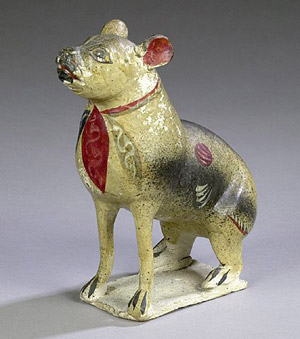
The origin of American chalkware is generally attributed to the Pennsylvania Dutch, first appearing in the mid 1800s as a low-cost decorative alternative to the more expensive English Staffordshire figures. These were often sold door to door by peddlers as late as 1900 until decorative objects made with more modern materials and manufacturing methods replaced them around the turn of the century.
Objects of molded plaster continued to be made as carnival prizes until the mid-20th century, at which time they were replaced by items like stuffed animals. Many forms of “carnival chalk” were of a different subject matter and style, like kewpie dolls and ethnic figures that were often politically incorrect by today’s standards. Molded and painted plaster sculpture are produced to this day, although items recently manufactured are sold as fakes to deceive collectors or as contemporary “antique” craft items.
The term chalkware is a misnomer because the material used is not actually chalk. Earliest examples are gypsum, the primary ingredient in plaster of paris. They were of hollow, thin wall construction, generally molded in two halves that were cemented together and paint-decorated in watercolor, occasionally in oils. Since chalkware is molded, many pieces have identical size and form and were able to retain their uniqueness through individual decorations. Early examples tend to be gaudy and not naturalistically represented. It would not be uncommon to find apples painted blue or another inappropriate color. Later examples were painted in tempera paints and typically are of solid rather than hollow construction.
Forms most commonly found in chalkware are dogs and cats, particularly spaniels and poodles, followed by animals such as squirrels, roosters, doves and parrots. More uncommon forms include lambs, sheep, swans, deer, lions and pigs. Holiday items and animals with nodding heads are rare. Fruit and floral mantel garnitures and holiday items are the highest demand. Watch hutches, unique to 19th-century life, were configured similar to a garden shrine. They had a round opening near the top for hanging a pocket watch to be visible from the front functioning as a mantel clock. Another scarce figural item is a building with openings for the windows where a candle could be placed, providing illumination from behind. These were the forerunners of the plastic buildings illuminated by tiny light bulbs sold today.
Nineteenth-century chalkware exemplifies the definition of folk art in its purest sense. Its manufacture required skill but no formal training. It represents everyday familiar objects and satisfies a desire for color and beauty through a simple medium. Chalkware truly was art made by the common folk for their own enjoyment.
Tips on Collecting Chalkware
- Hollow construction, thin walls and open bases are characteristics associated with earlier pieces of chalkware. Many times the bases have been filled to add weight, making it difficult for one to assess age and repairs.
- Avoid items with restoration unless they are of an exceedingly rare form. Paint age and coverage is paramount. Collectors consider coverage and gaudy decoration more desirable. An original paint-decorated surface will multiply the value of a piece by four to five times over lesser examples.
- Look for patina and signs of age, specifically a finely crazed, oxidized surface to the paint and evidence of wear, especially on the base. On items having age, the base material should exhibit a mellow, off-white color, not pure white, as would be the case with new plaster. Look underneath and inside the piece to examine the color; wear and evidence of repairs. The material is porous by nature, so examine the surface for signs of paint retouch. Repainted areas bleed into the base material or seep under the original decoration.
- Never attempt to clean the surface or touch up the paint. Scarcity is not always an indicator of value; animal figures and garnitures remain the most popular. Expect to pay from a few hundred to several thousand dollars for fine examples.
- Collector reference books written in the 1940s speak of items being reproduced in the 1930s using the old molds. It is difficult to identify reproductions, even for an experienced collector. The market is littered with reproductions that can be purchased on the Internet for less than $50. As with any antique item, do your homework, buy only from reputable dealers and auctioneers who will guarantee their offerings.
Wes Cowan is founder and owner of Cowan’s Auctions, Inc. in Cincinnati, Ohio. An expert on historic Americana, Wes stars in the PBS television series History Detectives and is a featured appraiser on Antiques Roadshow. Wes holds a B.A. and M.A. in anthropology from the University of Kentucky, and a Ph.D. in anthropology from the University of Michigan. He is a frequently requested speaker at antiques events around the country.


